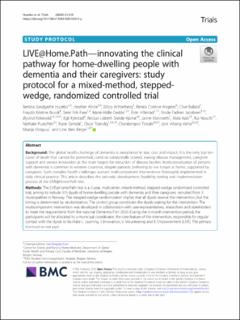| dc.contributor.author | Husebø, Bettina | |
| dc.contributor.author | Allore, Heather | |
| dc.contributor.author | Achterberg, Wilco | |
| dc.contributor.author | Angeles, Renira Corinne | |
| dc.contributor.author | Ballard, Clive | |
| dc.contributor.author | Bruvik, Frøydis Kristine | |
| dc.contributor.author | Fæø, Stein Erik | |
| dc.contributor.author | Gedde, Marie H. | |
| dc.contributor.author | Hillestad, Eirin | |
| dc.contributor.author | Jacobsen, Frode F. | |
| dc.contributor.author | Kirkevold, Øyvind | |
| dc.contributor.author | Kjerstad, Egil | |
| dc.contributor.author | Kjome, Reidun Lisbet Skeide | |
| dc.contributor.author | Mannseth, Janne | |
| dc.contributor.author | Naik, Mala | |
| dc.contributor.author | Nouchi, Rui | |
| dc.contributor.author | Puaschitz, Nathalie | |
| dc.contributor.author | Samdal, Rune | |
| dc.contributor.author | Tranvåg, Oscar | |
| dc.contributor.author | Tzoulis, Charalampos | |
| dc.contributor.author | Vahia, Ipsit Vihang | |
| dc.contributor.author | Vislapuu, Maarja | |
| dc.contributor.author | Berge, Line Iden | |
| dc.date.accessioned | 2021-03-16T09:47:53Z | |
| dc.date.available | 2021-03-16T09:47:53Z | |
| dc.date.created | 2021-02-21T20:06:25Z | |
| dc.date.issued | 2020 | |
| dc.identifier.citation | Trials. 2020, 21:510 1-16. | en_US |
| dc.identifier.issn | 1745-6215 | |
| dc.identifier.uri | https://hdl.handle.net/11250/2733562 | |
| dc.description.abstract | Background The global health challenge of dementia is exceptional in size, cost and impact. It is the only top ten cause of death that cannot be prevented, cured or substantially slowed, leaving disease management, caregiver support and service innovation as the main targets for reduction of disease burden. Institutionalization of persons with dementia is common in western countries, despite patients preferring to live longer at home, supported by caregivers. Such complex health challenges warrant multicomponent interventions thoroughly implemented in daily clinical practice. This article describes the rationale, development, feasibility testing and implementation process of the LIVE@Home.Path trial. Methods The LIVE@Home.Path trial is a 2-year, multicenter, mixed-method, stepped-wedge randomized controlled trial, aiming to include 315 dyads of home-dwelling people with dementia and their caregivers, recruited from 3 municipalities in Norway. The stepped-wedge randomization implies that all dyads receive the intervention, but the timing is determined by randomization. The control group constitutes the dyads waiting for the intervention. The multicomponent intervention was developed in collaboration with user-representatives, researchers and stakeholders to meet the requirements from the national Dementia Plan 2020. During the 6-month intervention period, the participants will be allocated to a municipal coordinator, the core feature of the intervention, responsible for regular contact with the dyads to facilitate L: Learning, I: Innovation, V: Volunteering and E: Empowerment (LIVE). The primary outcome is resource utilization. This is measured by the Resource Utilization in Dementia (RUD) instrument and the Relative Stress Scale (RSS), reflecting that resource utilization is more than the actual time required for caring but also how burdensome the task is experienced by the caregiver. Discussion We expect the implementation of LIVE to lead to a pathway for dementia treatment and care which is cost-effective, compared to treatment as usual, and will support high-quality independent living, at home. | en_US |
| dc.language.iso | eng | en_US |
| dc.publisher | BMC | en_US |
| dc.rights | Navngivelse 4.0 Internasjonal | * |
| dc.rights.uri | http://creativecommons.org/licenses/by/4.0/deed.no | * |
| dc.title | LIVE@Home.Path--innovating the clinical pathway for home-dwelling people with dementia and their caregivers: Study protocol for a mixed-method, stepped-wedge, randomized controlled trial | en_US |
| dc.type | Peer reviewed | en_US |
| dc.type | Journal article | en_US |
| dc.description.version | publishedVersion | en_US |
| dc.source.pagenumber | 1-16 | en_US |
| dc.source.volume | 21:510 | en_US |
| dc.source.journal | Trials | en_US |
| dc.identifier.doi | 10.1186/s13063-020-04414-y | |
| dc.identifier.cristin | 1892137 | |
| dc.description.localcode | © The Author(s). 2020 Open Access This article is licensed under a Creative Commons Attribution 4.0 International License, which permits use, sharing, adaptation, distribution and reproduction in any medium or format, as long as you give appropriate credit to the original author(s) and the source, provide a link to the Creative Commons licence, and indicate if changes were made. The images or other third party material in this article are included in the article's Creative Commons licence, unless indicated otherwise in a credit line to the material. If material is not included in the article's Creative Commons licence and your intended use is not permitted by statutory regulation or exceeds the permitted use, you will need to obtain permission directly from the copyright holder. To view a copy of this licence, visit http://creativecommons.org/licenses/by/4.0/. The Creative Commons Public Domain Dedication waiver (http://creativecommons.org/publicdomain/zero/1.0/) applies to the data made available in this article, unless otherwise stated in a credit line to the data. | en_US |
| cristin.ispublished | true | |
| cristin.fulltext | original | |
| cristin.qualitycode | 1 | |

